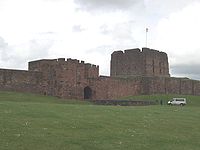Coordinates: 54°53′42″N 2°56′02″W / 54.895°N 2.934°W
| Siege of Carlisle | |||||||
|---|---|---|---|---|---|---|---|
| Part of the Jacobite Rising of 1745 | |||||||
 Carlisle Castle | |||||||
| |||||||
| Belligerents | |||||||
|
|
| ||||||
| Commanders and leaders | |||||||
| Duke of Cumberland | Unknown | ||||||
The Siege of Carlisle took place during the Jacobite Rising of 1745–46 after Charles Edward Stuart (Bonnie Prince Charlie) was forced to retreat north back into Scotland. As the retreat was totally against his will, he left a small force of 400 men to garrison Carlisle mainly consisting of members of the English Jacobite regiment called the Manchester Regiment, so that Charles could say that he at least held one town in England for his hoped-for return. The Jacobite garrison left to hold Carlisle surrendered to overwhelming Hanoverian forces under the Duke of Cumberland.
The troops of the Duke of Cumberland reached Carlisle on 21 December 1745 and immediately began to besiege and bombard the town. The garrison resisted for nine days but on 30 December, requested terms from Cumberland, who replied, "The only conditions he could grant to rebels were that they should not be put to the sword, but be reserved for the king's pleasure."[1]
Treatment of prisoners[]
The "King's pleasure" involved Jacobite prisoners being crammed into a dungeon in Carlisle Castle without food, water or sanitation facilities until they were brought out for execution. The so-called "licking-stones", where desperate prisoners licked the walls to obtain some moisture, can still be seen today. [2] The executions were staggered, with some of the officers sent to London to be hanged, drawn and quartered for high treason.
See also[]
- Siege of Carlisle
- The Bonnie Banks o' Loch Lomond
External links[]
The original article can be found at Siege of Carlisle (December 1745) and the edit history here.